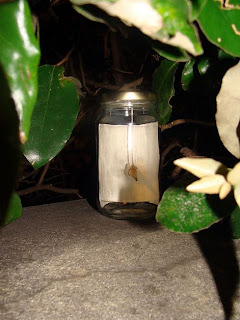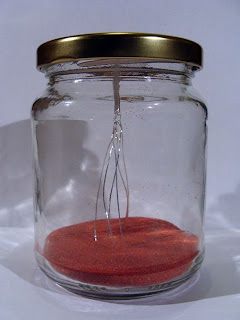 |
| Jar 96: paper, pencil, nettle yarn. |
Philip: What made you want to start this project?
Kirsty: It’s really a cunningly disguised exercise regime. I wanted to walk every day and knew that the only way I’d do it was to incorporate it into an art piece.
There were other motivations too. Towards the end of last year I was working very hard on my consulting business and started to feel that my art was being pushed to one side. I wanted to replace art in the centre of my life and achieve a better balance. Of course now I don’t have enough time for the consulting business!
Philip: How much work does it require each day?
Kirsty: It’s usually at least two hours of work every single day and I frequently have whole days when I do nothing but the jar project. Basically it never leaves me.
Not only do I have to make the jars, go on my Jar Walk, document the placing of the jars with photographs, I also have to edit and upload the photos and write the daily blog post.
Then there’s all the hidden work: ordering materials; testing out ideas that don’t work; updating the jar databases; revisting jars to see if they’re still there; blogging about found and missing jars; answering emails and comments about the project.
It’s a bit relentless, to be honest. Fortunately I mostly enjoy it.
 |
| Jar 96 in situ |
Kirsty: Some relate very strongly – I’ve been consciously making ‘mini versions’ of some of my larger sculptures with the underlying idea that I’m having a year-long retrospective in jars. Several people have said that they appreciate being introduced to my back catalogue in this way. Certainly you could look at the jar project and get a very accurate feel for my work.
From my point of view, the project has a certain ‘decluttering’ quality to it. For example, I’m getting rid of a lot of old drawings and having a chance to use up lots of my art supplies. It’s also a way for me to explore all those niggly little ideas that didn’t seem big or important enough to justify a large, time-consuming sculpture. It feels as though I’m clearing space for new work to take root and I sense that this project is going to be a pivotal point in my art.
 |
| Jar 95: wire and red sand |
Philip: What was a) the most negative and b) the most positive response you’ve had so far?
Kirsty: The vast majority of people have been overwhelmingly positive. I love my Jar Fans, they’re wildly enthusiastic about the project and keep me going on the days when it’s a real struggle.
I think the most positive reaction has come from Mark, The Intrepid Jar Hunter. He’s a Bristol guy who found one of the earliest jars by accident and then started actively and somewhat obsessively hunting for them. It’s become a hobby for him. He’s found 21 jars to date and his passion for the project is obvious in the detailed, entertaining and insightful jar forms he submits. My international Jar Fans particularly adore him because he gives them a window into what finding a jar is like – they can’t get out to find jars themselves so they tend to live vicariously through Mark.
Amazingly I’ve only had two openly negative reactions so far and one of those later apologised and retracted what he’d said. So the most negative reaction was when someone raged at me about what I was doing. He just hated it, thought it was litter and that I was interfering with people’s appreciation of nature. It was clear that I’d triggered some kind of knee-jerk reaction because he hadn’t even realised that the vast majority of the jars are released in urban areas. He was so aggressive about it that I deleted his comment from the site: I don’t mind disagreement and being challenged about my ideas but I won’t stand for trollish behaviour and name-calling.
Philip: Quite right too! What were your expectations about the project before you started it, and have they changed in any way?
Kirsty: Well, it’s definitely been far more work than I anticipated!
I honestly thought I could continue several other projects and even start some new ones whilst doing the jars but that hasn’t been the case at all. I didn’t realise how epic and all-consuming it was going to be and I’ve had to massively readjust my plans for the year.
 |
| Jar 95, close-up. |
The Jar Walks themselves have been a delightful revelation. Even on days when I can’t walk very far because of poor health - I’ve been diagnosed with ME/Chronic Fatigue Syndrome and have a dodgy immune system – it feels so good to get out and walk. I’ve learnt so much about my local area and I feel connected to it in a way I didn’t before: I have a much more cohesive internal map of it now.
One of my biggest surprises was how quickly it took off. I was expecting to have a month or two where no one paid very much attention but that didn’t happen. I’ve had decent visitor numbers right from the start and I’ve not done much promotion, so it’s real word-of-mouth stuff.
Another surprise has been how Jar Finders engage with the project. For example, some people decided to replace the jars back outside in new spots. It hadn’t occurred to me that people might do that but I think it’s wonderful. People have really thrown themselves into the spirit of the project and that’s been so exciting, it feels as though the whole thing has a momentum and a meaning that’s far beyond me.
Follow the project at 365 Jars.